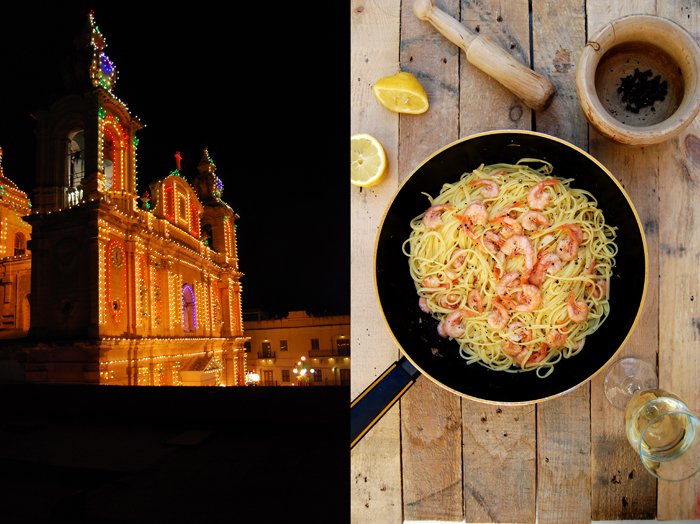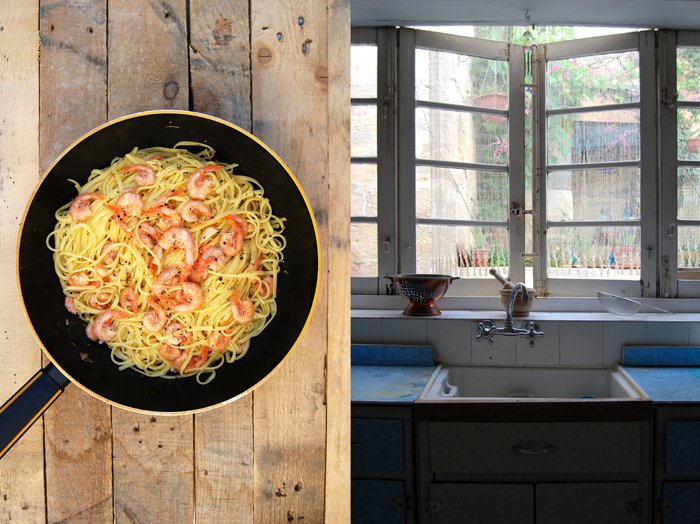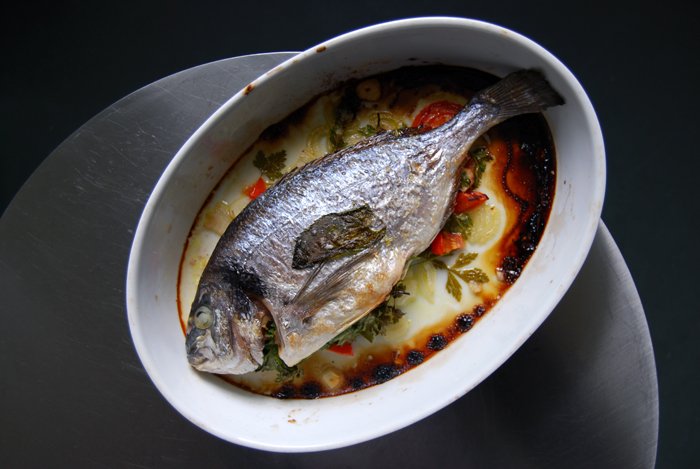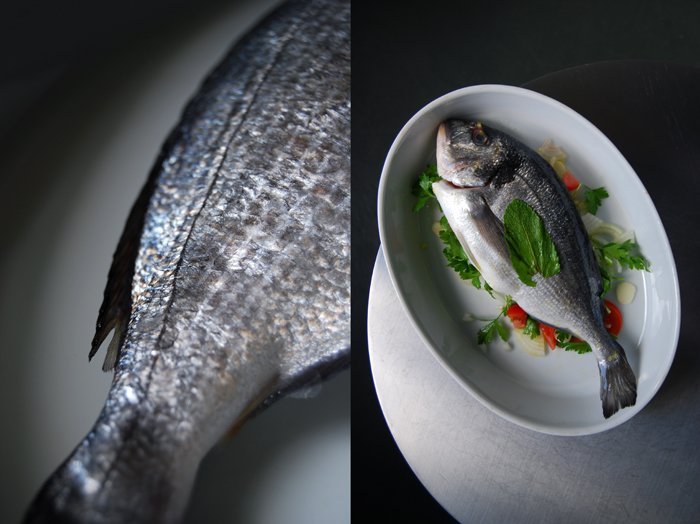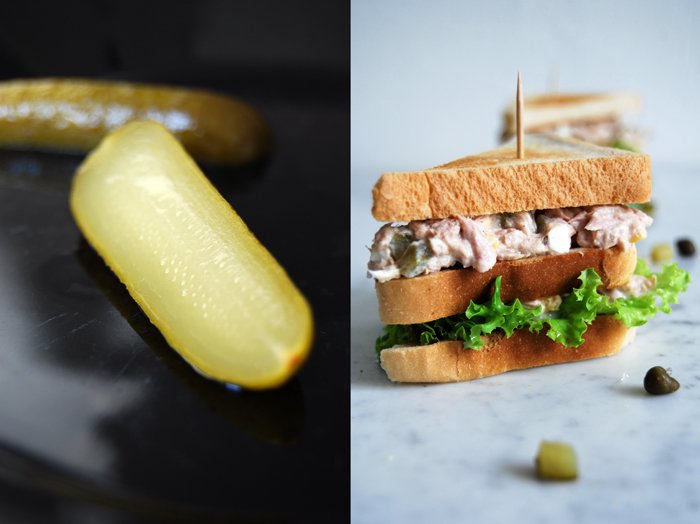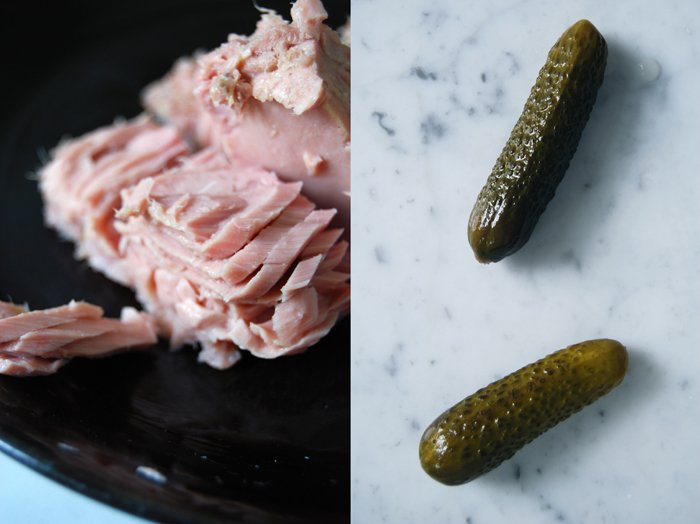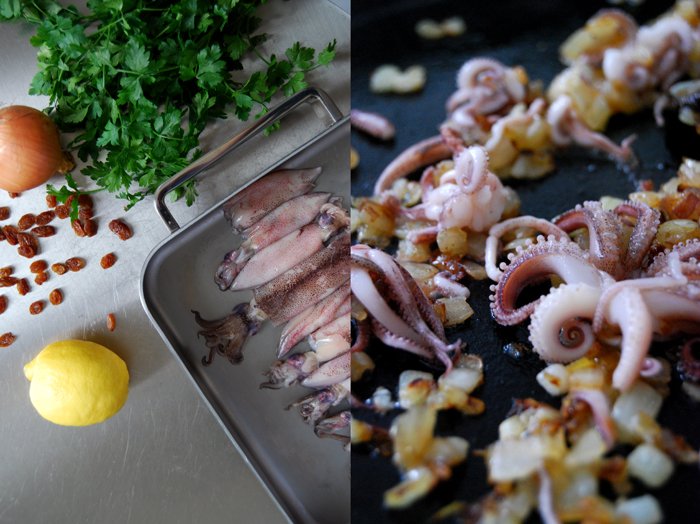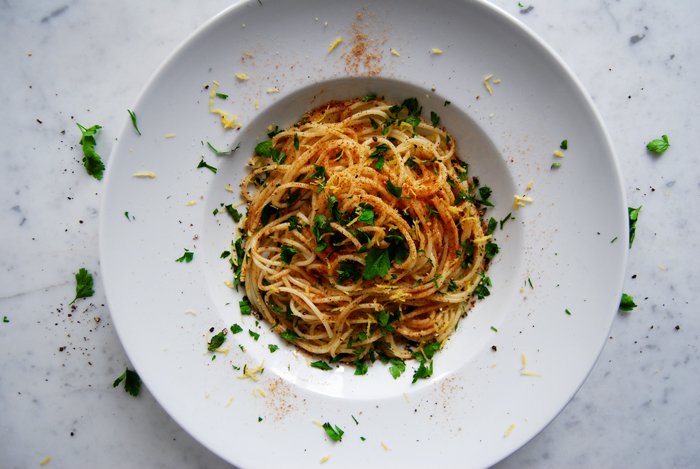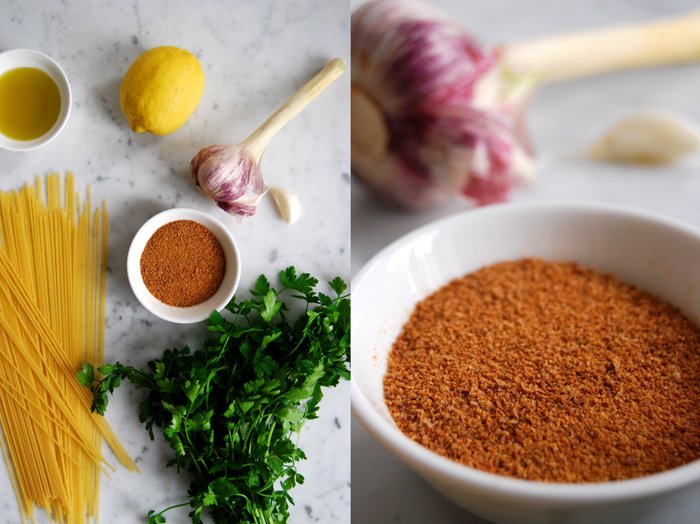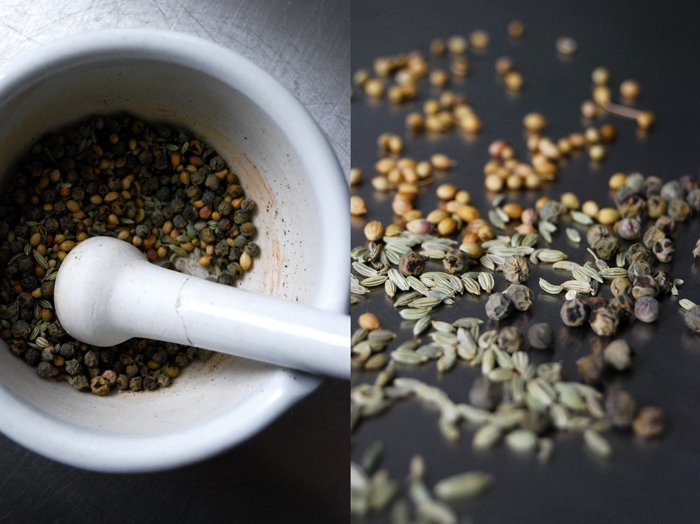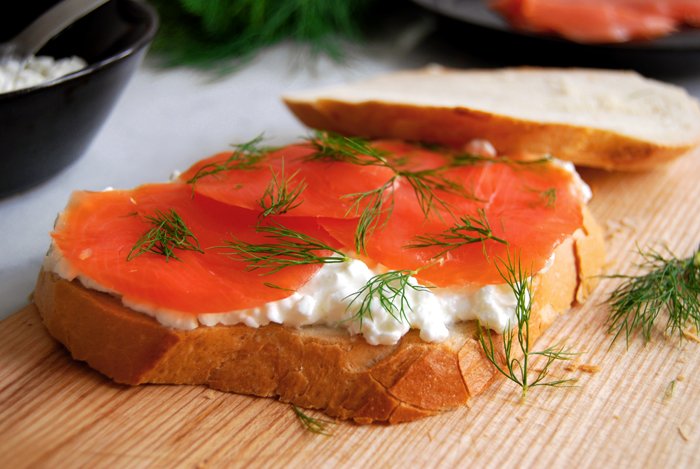Prawn Polpetti by the Fisherman's Wife
When the fish monger offered us a big bag of Maltese prawns for a great price we couldn't refuse it. As the morning comes to an end, the fishermen just want to empty their tables to go home and sleep! Before we left the market, one of the fishermen's wives told us about one of her favourite recipes to prepare with prawns, golden fried polpetties. We took a few quick notes and off we went to the frying pan in the kitchen!
This recipe is very simple and brings out the best in the prawns, you just chop and mix them with some flour, garlic and salt and fry them in butter until they turn into golden patties. You could add some parsley, but we wanted to keep them pure and simple. Don't be put off by the fact that the patties aren't little beauties, their taste makes up for it!
Golden Fried Prawn Polpetties
For two people you need
prawns, shelled and chopped, 300g / 10.5 ounces
plain flour 4 heaping tablespoons
garlic, crushed, 1 big clove
salt 1/4 teaspoon plus more to taste
butter
lemon
Mix the ingredients and form little patties. Heat the butter in a pan. Fry the polpetties for 2-3 minutes on each side or until golden brown.
Serve them warm, sprinkled with a little lemon juice.
Grilled Amberjack with Mint Oil
Here is another one of our Marsaxlokk fish market purchases, firm amberjack steaks! When I wrote about my Moscato Prawn Pasta last week I mentioned the small town's Sunday market that turns the picturesque promenade at the seafront into a busy scene of fishermen offering their fresh catches and farmers piling up their colourful harvest. Green boxes filled with melons, tomatoes, zucchinis and peaches made my mouth water before we even started our shopping!
The small path between the stalls was packed with people looking for the nicest piece of tuna or swordfish, trying to spot the fisherman offering the freshest Maltese prawns, mackerel, barracuda or octopus. We bought far more than we had planned but we couldn't resist when we saw all the wonderful seafood in front of us. After 30 minutes of choosing the fish we wanted and bargaining here and there, we started to feel a bit exhausted. The heat reached its peak and forced us to take a break. We ate a nice big watermelon, sweet and juicy and found a little spot in the shade right next to the colourful boats swaying gently in the crystal clear water.
Sometimes when we visit Marsaxlokk we sit down in one of the cafes at the piazza in front of the church and enjoy a little snack with our espresso, or we go to one of my beloved Pastizzerias! You can find these little bakeries all over the island selling some of my favourite Maltese treats, little pies filled with ricotta or spinach and anchovies. One of these pies is Pastizzi, a flaky puff pastry shell which is so delicate that it crumbles between your buttery fingers, you can also get these filled with peas. The other one is called Qassatat, the pastry is less rich and more like short crust. If you come to Malta you should try these traditional pastry delicacies, that's what many Maltese miss the most (apart from their bread!) when they live abroad!
Back to the amberjack, when we came home we started the grill and cooked the fish without any seasoning. You could also sauté it in a pan and cook it in the oven for a few minutes at 200°C (390°F). It's summertime, the kitchen is already hot and we have the gas barbecue ready in the garden so we decided to grill it. I mixed some olive oil with lemon juice and fresh mint leaves to sprinkle over the cooked fish and over a few slices of tomatoes - no salt, no pepper!
At first, my boyfriend wanted to enjoy the pure taste of the amberjack without the aromatic mint oil but when he smelled (and tasted) it on my steak he changed his mind! Fish and mint works just too well together!
Grilled Amberjack with Mint Oil and Tomatoes
For 2 hungry people you need
amberjack steaks (around 1,5cm / 1/2" thick) 400g / 14 ounces
olive oil 4 tablespoons
freshly squeezed lemon juice 1 1/2 tablespoons
fresh mint leaves, cut into thin slices, 10
tomatoes, quartered, 3
For the mint oil, whisk the olive oil with the lemon juice and mint leaves.
Cook the steaks on the grill for a few minutes on both sides until golden and cooked through. You should be able to lift the fish off the bone when it's done.
If you cook the fish in a pan, heat a little olive oil and sauté the fish for 1-2 minutes on both sides until golden. Cook in the oven at 200°C (390°F) for about 8 minutes.
Arrange the tomatoes and amberjack on a big plate an sprinkle both with the mint oil.
meet in your kitchen | Kurt Micallef cooks Octopus with Fennel and Kombu Potatoes
A couple days ago I met a rising star of the Maltese cooking scene, Kurt Micallef, in the kitchen of one of Malta's best fish-centric restaurants, Tartarun in Marsaxlokk. Kurt has been at the top of my list of chefs to meet for quite a while, I've heard so much about his work that I got in touch with him as soon as my flights were booked! We decided to transfer the meet in your kitchen feature to his work space at Tartarun as this is the kitchen where he spends most of his time cooking and working on new creations.
Kurt grew up in Malta in a family of butchers in the third generation but decided to start a career as a chef. He moved to London, where he studied and gathered experiences in a couple Michelin starred restaurants. However, he found his biggest inspiration at In De Wulf in Belgium, a renowned restaurant where the philosphy is to use local produce and work with traditional methods of cooking combined with a modern presentation. Simple but refined, this is the culinary style he can relate to. For eat in my kitchen, he chose to share a wonderful composition of his which focuses on two of Malta's most present flavours, seafood and fennel. He combines slightly smokey octopus which he first cooked in broth before he char grilled it with compressed fennel bulb, potatoes cooked with Kombu, squid ink emulsion and fennel flowers and fronds.
I was so impressed by the meal that Kurt created for us, the smokey octopus and strong fennel aroma are a perfect match and I will definitely use it in my own kitchen!
Octopus char grilled, compressed Fennel Bulb, Potato cooked with Kombu, Squid Ink Emulsion, Fennel Flowers and Fronds
For the octopus
medium octopus 1
lemons, sliced, 1onions, sliced, 2
garlic head , sliced, 1
bay leaves 3
fennel seeds 10
star anise 1
Make a stock with the onions, garlic, lemons, fennel seeds, star anise and water. When the desired flavour is achieved add the octopus and simmer for 40 minutes or until tender but not stringy.Leave to cool in the cooking liquor. Remove octopus and break down into separate tentacles. Reserve the octopus and cooking liquor for later use.
For the fennel oil
fennel fronds 100g / 3.5 ounces
grape seed oil 100g / 3.5 ounces
Combine the fennel fronds and grape seed oil in a blender and blend until smooth. Transfer to a pan and bring to 60 degrees.
Remove from the heat, cover with cling film and leave to infuse for 1 hour. Pass the oil through a chinois lined with Muslin Cloth.The oil should be clear with a green hue and fennel flavor.
For the compressed fennel
fennel bulb 1
fennel oil 10ml / 1/3 ounces
fennel juice 10ml / 1/3 ounces
lemon juice 10ml / 1/3 ounces
Slice the fennel bulb lengthwise on a mandolin into 2mm thick slices. Trim the root off and transfer to a vacuum bag with the oil and juices. Compress and leave to marinate for 10 minutes. Drain on paper towels and season lightly with salt.
For the potatoes
baby potatoes 100g / 3.5 ounces
Kombu 1 sheet
water 500ml / 17 ounces
In a pan bring the water to 60 degrees, add the kombu and simmer for 20 minutes. Discard the Kombu and add the potatoes, cook until done, approx. 15 - 20 minutes. Remove from pan and leave to cool slightly. Peel the skins from the potatoes and reserve for later use.
For the squid ink emulsion
liquid from cooking the octopus, strained, 25ml / 2/3 ounces
squid ink 1 teaspoon
white wine vinegar 1 teaspoon
In a bowl, combine all the ingredients and whisk until emulsified, adjust seasoning and reserve for later use.
For the Nori paste
shallot, chopped, 30g / 1 ounce
white onion, chopped, 40g / 1.5 ounces
garlic, 1 clove
grape seed oil
lemon zest
nori14g / 1/2 ounces
Combine the shallot, onion and garlic in a pan, cover with oil and place on low heat. Cover with a cartouche and cook for 15 minutes until tender. Meanwhile toast the nori over an open flame until it changes color. Remove the onion mixture off the heat, add the nori and cover with cling film. Leave for 1 hour to infuse. Drain mixture reserving the oil. Chop the onion mixture into a paste and season well with lemon zest, add enough oil to the mixture to bind. Reserve for service.
Garnishes
dill flowers
fennel fronds
fennel flowers
Assembling
Lightly drizzle the octopus with grapeseed oil and season with salt. Grill the octopus on a charcoal bbq or a grill until lightly charred and a smoky taste is obtained.
In a bowl combine the potatoes with the seaweed paste until nicely coated.
Smear the squid emulsion in the centre of the plate. Build the composition with the octopus and compressed fennel on the squid ink emulsion, add 3 potatoes and garnish with the fronds and flowers.
You studied French Cuisine at Le Cordon Bleu in London, what moved you to start your culinary education in London?
I did my Diploma in Cuisine at Le Cordon Bleu in London. The diploma was only 9 months long and this was a major factor I took into consideration when I chose the diploma. I decided to become a chef at the age of 22, which is considered as already being too late for the industry. Another factor was that it is considered to be one of the best culinary schools in the world, which provides you with solid fundamental skills in the kitchen. This gave me a good foundation. I later developed further skills by working in different kitchens around London.
You worked at several Michelin starred restaurants, which one influenced your cooking the most and why?
During my year studying in London, I staged (apprenticed) in a couple of Michelin starred kitchens to continue learning and developing myself as a chef. However, the greatest influence was brought forward through a two month internship at In De Wulf in Dranouter, Belgium. This is a 1 Michelin starred restaurant with a unique concept. The chef there, Kobe Desramaults, took over his mother's restaurant which was a casual brasserie in the middle of nowhere, for travellers going back and forth from France to Belgium. He revamped the restaurant and focused on doing high end food, using local produce from neighbouring villages. The philosophy of the restaurant is that of being local and using nature as inspiration. They focus on an old style of cooking, but present it in a modern way. The use of wood burning ovens, smoking, foraging, pickling and fermenting was something new to me, and this really inspired me. I fell in love with the food there; it was so simple yet so refined.I knew this was the kind of food that I wanted to cook. I returned back for another 2 month stage the year after. I worked on the garnish section, which meant I was in charge of the preparation and cooking of vegetables and herbs for the hot section. Through this section, I mastered in speed and organization. One has to be quick and know what one's doing. The menu had 13 hot dishes for 40 covers, so the orders came in pretty quick.
After working abroad in the past few years you moved back to your home island Malta, how did this feel? Did you consider staying abroad?
It was awkward at first and I found it difficult to fit back in to the routine. In the 4 years I've been cooking, I struggled to find the right place for me to work, and that is why I bounced from one job to another, leaving the country and coming back.I have finally found a place where I feel I can make use of the skills I have developed along my journey. I do get the urge to go back and work abroad as the opportunities for learning are much bigger there. Malta is a very small island with limited opportunities, but at the end of the day this is the place I call home. I cannot see myself being away from this island for a long time. I am currently working at Tartarun restaurant & lounge. I am a chef de partie on the Cold / Pass section. This is a fish-driven restaurant, which is much different to what I have experienced before. Nevertheless, I find it very interesting. Here I can develop my skills on how to handle fish properly. The management in the restaurant gives us a lot of free will to come up with daily specials, so for me this was a very big step to further develop my skills with regards to fish.
Your father is a butcher in the 3rd generation, did you ever consider following this family tradition and why did you decide against it?
My father owns his own business at the abattoir. He buys cattle and slaughters it, and sells to butchers across the island. To be quite honest, I was petrified of my father's job when I was a young kid! I still remember the first time going with my father to the abattoir and watch them slaughter a cow. It was quite a shock to me at that age and it pushed me away from continuing my father's line of work. Today, I have a deep respect for what my father does, and I love the art of butchery, which I think is a lost art since most of the meats that are purchased today come pre butchered and in vacuum bags. It is something which I keep close to my heart. I would rather get in a whole pig, butcher it and utilize all of it, rather than buy pre butchered meat. I guess I am still keeping a bit of the family tradition going on! The other factor is that it is a dying trade. Malta is a very small island with little-to-no pasture land for cattle to grow on. Most butchers nowadays buy their meats from wholesale importers who bring in meats from all over the world, as most of the times, the price is cheaper and they can not compete within the local market.
Who was your biggest influence in the kitchen and why?
The biggest influence on me becoming a cook has to be my grandmother. Prior to getting married, she was a nun, cooking in monasteries in Belgium and Italy for foster kids. She then married my grandfather and raised a family. Food was and still is family time in our households. She is 83 years old today and still cooks everyday for her kids, Wednesdays are our days to go and have lunch at grandma's house. She has a large garden which she grows most of the vegetables she cooks, and this really is something which I love. Growing your own produce, harvesting it and cooking it for people, how better can it get!
What is your kitchen philosophy?
I try to cook food that is, first of all, delicious but at the same time sustainable. I like to cook depending on the seasons, and not use produce imported from across the world with little-to-no flavour. My experience from In de Wulf has influenced my cooking quite a bit. What I have learnt there, I am utilizing in my cooking now. Food there was always light and does not weigh you down; they focused a lot on vegetable cooking which is something that I try and do. I try to balance my dishes by using fresh herbs and acidity to make food seem lighter. I am also experimenting with fermenting which is something we do not do in Malta and I find the flavours to be amazing. I have a couple of items fermenting in my kitchen cupboard which sometimes work and sometimes don't, but that is a learning curve for me. I learn from my mistakes and keep notebooks with my experiments. In my cooking, I try to fuse the old and new style of cooking, always focusing on the produce first, then the technique. If it doesn't taste good, then technique is a waste of time. It has to taste good first and foremost. I am also interested in Japanese cuisine mostly Kaiseki. The way they balance flavours and the discipline in perfecting their food is something that fascinates me.
What was the first dish you cooked on your own, what is your first cooking memory?
The first dish I cooked on my own has to be veal parmigiana; which involves veal escallops coated in breadcrumbs and pan fried, then coated with a tomato sauce, mozzarella and parmesan and then baked in the oven. This was around when I was 13 years old. My first food memory has to be my grandmother's oxtail soup. I still crave it and always hope that grandma will cook that when we go over for lunch. It is a simple household dish which has deep flavours from the vegetables and the oxtail. Just thinking about it makes me crave for it!
How do you develop new recipes? What inspires you?
Developing new recipes is not easy for me. I am not that type of person that can come up with something on the fly. I think about a dish, and try and picture it in my head before I actually start cooking. I start with the main ingredient I want to work with, then start finding things that pair well with the main ingredient. I then move on to the technique, and see which one works well with the selected ingredients. I write all my recipes out, and then start cooking and experimenting. Don't get me wrong, there are times when an idea pops in my head, and it turns out right, but for the most part it involves a trial and error process. I get inspirations from various things, but mostly books and food blogs. I try and see what chefs from all around the world are doing and take inspiration from that. I take ideas, and then try and develop them in my own style. Nature also inspires me. When I have some free time, I love to go for walks by the seaside or fields. This clears my mind and let's me think about some dishes I want do. I sometimes also find wild ingredients, which I can use in my cooking.
What are your projects for the future?
The big dream is to have my own restaurant one day. I want to have a small restaurant, and the idea of a tasting menu intrigues me, as one can showcase his or her style in a progression. This is something which you rarely see in Malta, since most of the restaurants offer a la carte. I want to have a place where I can express myself on a plate in different progressions, rather than 1 plate. Also, a menu that is not tied down to what is written on it. For instance, if I have a carrots dish, and the carrots are not of good quality, then I won't serve it, but adapt to something that is good at that time. At this point, I am aiming to work hard where I am, and gather as much knowledge as possible, further develop my skills and never stop learning.
What are your favourite places to buy and enjoy food in Malta?
I love going to the farmers' market in Ta' Qali, where I can buy goods that are fresh and in season. Also, new ideas can spark up when I'm there, such as a new vegetable that I didn't know about, or maybe a purveyor selling local honey.I love cooking but on my days off I'd rather go and eat out, and my favourite places in Malta have to be Black Pig and Il- Horza, which are fine dining restaurants serving really good food. Sammy's by Culinary Forward Malta is doing really interesting work, as it is the first restaurant I know of that is purely local, for really good fish I'll go to Tartarun restaurant, even though it's my work place I don't mind going for some good fish and lastly Ali Baba, which is a middle eastern restaurant with mind blowing food.
What did you choose to share on eat in my kitchen and why?
I have decided to do a seasonal fish dish, to showcase where I am at right now in my journey. The dish is a local octopus which is grilled, served with raw fennel, marinated in its own juice and lemon, a squid ink emulsion using the cooking liquor and ink sack from the octopus hence utilizing the whole animal once again; together with baby potatoes coated in a seaweed paste to bring some earthiness, and some fresh seasonal herbs to balance and keep the dish light. With this dish, I will try to balance the land and the sea, which I think reflects Malta, since it is an island with bounties from the sea and land.
If you could choose one person to cook a meal for, who and what would it be?
My grandfather. Unfortunately, he passed away before I became a chef. I have deep respect for him, for the man he was. He loved food, especially meat. He worked in meat for all his life and never got tired of eating it as well. I would cook a nice steak with bernaise sauce for him and I'm sure he would love it!
You're going to have ten friends over for a spontaneous dinner, what will be on the table?
When I have time to cook at home, I tend to fall back on simple recipes, and one thing I keep on going back over and over to would be a Ramen - a nice pork broth infused with seaweed, some noodles, soft boiled, egg, roasted pork belly, seasonal greens and some pickles. Hits the spot every time!
What was your childhood's culinary favourite and what is it now?
Still has to be my grandma's oxtail soup, love that dish! Also, my mother cooks a pretty good lasagna, so those two dishes will be at the top for home cooked meals.
Do you prefer to cook on your own or together with others?
Working in a kitchen, I have learnt that it's all about team work. You can't run the show on your own. So yes, definitely with others. We all help each other out.
Which meals do you prefer in your own kitchen, improvised or planned?
When I'm at home cooking for myself, I'll improvise, but when it comes to work I prefer to plan it out.
Thank you Kurt!
Moscato Prawn Pasta and a Festa to celebrate our arrival in Malta
I'm finally back in Malta! I can't describe how much I've been looking forward to having my feet on Maltese ground again. I just wanted to smell the air, feel the sun on my skin and see all the beloved faces at the airport again - and finally we're here again!
When I went to Malta for the first time I learnt that the arrival at the airport is the beginning of a big, endless family feast. Aunts and uncles, cousins, the grandmother of course, sisters, brothers and my Maltese Mama Jenny, there is always a big welcoming committee waiting for us at the gate and escorting us to the house in Msida, our home town for the weeks to come. On the way there I took a deep breath of the salty air mixed with the sweet scent of oleander and wild thyme, this is Malta to me!
In the next weeks I'll be cooking and baking in Jenny's kitchen - and her garden as that's where the grill is. I will share some of my favourite summer dishes with you, show you around on the islands a bit and introduce some passionate food and wine lovers to you. I will show you this wonderful place in the Mediterranean through my eyes but for a bigger picture I will be meeting and writing about Arnold, the bee keeper and Sam who produces his own olive oil, my baker, the butcher, farmers, wine and cheese makers, chefs and Maltese Mamas who've been cooking traditional meals for their families for many years. We will exchange recipes so that you and l can get the chance to learn a few more secrets of traditional Maltese cooking. These people, their profession and passion will show you the side of Malta that I fell in love with nine years ago. I hope I can give you an insight into this culture and food but also its warm, hospitable people who make me feel at home every time I come back.
One of the many things I'm always looking forward to impatiently when we're in Malta is to go to the fish market in Marsaxlokk in the south of the island. The freshness and variety is overwhelming, especially for someone like me who lives in the city far away from any water (apart from rivers and lakes). Every Sunday, the fishermen offer their catch of the last night. They go out in the dark into the open sea with their colourful boats in blue, red and yellow to come back from their fishing trip a few hours or days later and fill their tables with swordfish, tuna, sea bream, moray eels, prawns and many more. These aren't big companies, these are families who have been in the fishing business for many generations.We went there yesterday and I didn't know where to start and when to stop filling our ice box!
One of our purchases were Maltese prawns, the best I ever ate, almost sweet in taste. We threw them on the grill with some garlic and lemon, and enjoyed them with Maltese bread and wine to celebrate our arrival!
Next time when I write about one of our seafood meals I will tell you a bit more about Marsaxlokk, the fishing village and it's picturesque atmosphere but for now I'm off to the beach!
The weekend of our arrival happened to be Msida's Festa - the holy feast - in honour of Saint Joseph. Each village praises its patron saint with days of celebration including fireworks and a long procession with the saint's statue carried through the whole village. If you ever get the chance to join a Festa in Malta you will understand a lot about the Maltese culture, its traditions but also about the people's untamable will to celebrate and enjoy life!
Moscato Prawns with Linguine
For 4 people you need
linguine 300g / 10.5 ounces
prawns (in their shells, the heads removed) 300g / 10.5 ounces
garlic, quartered, 2 big cloves
Moscato wine 75ml / 2.5 ounces
water used to cook the pasta, 50ml / 1 3/4 ounces
freshly squeezed lemon juice, 2 tablespoons plus more to taste
olive oil
black peppercorns, crushed in a mortar
salt
Cook the pasta al dente in lots of salted water.
In a large pan, heat a splash of olive oil together with the garlic. When the oil is hot add the prawns and sauté for 1 minute. Deglaze with half of the wine, add the rest of the wine, the lemon juice and the water. Mix in the pasta and season with salt, crushed pepper and lemon juice to taste, serve immediately.
Blini with Roe Cream and Dill
I'm surrounded by caviar lovers, especially my mother who still talks about the tiny blue can I gave her as a present when I was still a child. I knew how much she loved it and I felt so proud and grown up when I bought it for her! The prices for this delicacy were much lower than they are now, unfortunately, those days are over. No black eggs as presents anymore!
Personally, I'm not crazy about it, I like and appreciate its fresh sea taste but the (much cheaper) red trout caviar is also fine for me. However I've been wanting to cook with it for quite a while and the time has come. I decided to go for the classic combination of buckweat blinis, roe cream and dill. It's perfect for a summer brunch or as a starter for a dinner party, a small sumptuous treat!
The dip is also great on dark rye bread!
Blini with Roe Cream and Dill
For 24 blinis you need
plain flour 100g / 3.5 ounces
buckwheat flour 50g / 1 3/4 ounces
dry yeast 2 leveled teaspoons
salt 1 teaspoon
a pinch of sugar
organic eggs 2
sour cream 100g / 3.5 ounces
milk, lukewarm, 200ml / 7 ounces
butter, melted, cooled off, 1 tablespoon
vegetable oil for frying
Combine the flour, buckwheat, salt, sugar and yeast. Add the milk, egg yolks, sour cream and butter and mix until well combined. Let the dough rise in a 35°C / 95°F warm ( top / bottom heat, no fan!) oven for 45 minutes.
Beat the egg whites with a pinch of salt till stiff and fold into the dough before you cook it.
Heat a non-stick pan on a high-medium temperature and coat with a thin layer of oil. Pour in 2 tablespoons of batter for each blini and cook for around 1 minute on each side or until golden brown.
For the roe cream
trout caviar 100g / 3.5 ounces
cream cheese 200g / 7 ounces
sour cream 6 tablespoons
lemon zest 1 teaspoon
freshly squeezed lemon juice 2 teaspoons
salt and pepper
fresh dill, chopped, a small bunch, for topping
Whisk the cream cheese, sour cream, lemon zest and juice and season with salt (carefully, the roe will add some saltiness) and pepper to taste. Gently fold in the roe, leave a few to garnish the blinis.
Dollop a spoonful of the dip on each blini and top with some roe and dill.
Sea Bream with Mint and Parsley on Onion and Tomato
A whole fish cooked in one piece is ideal to stuff with herbs, vegetables or spices. Be it baked in the oven or on the grill, the meat doesn't dry out and absorbs all the strong aromas, it's my favourite way to cook it. It's also less fragile to handle, a fact that always puts me off when I think of flipping over thin fish fillets in a pan.
When I cook a whole fish in the oven I simply follow my nose, at one point the air is filled with the smell of cooked fish and that's the sign for me to check it. I make a short cut along the middle line on one side to see if I can lift the fillet off the bone. Most of the time this works, but don't worry I will give you a time you can set for this sea bream recipe!
I stuffed the bream with parsley and mint and put it on a bed of onion, tomato and garlic, a splash of white wine on top and 20 minutes later my kitchen was filled with the most wonderful aroma. I could trust my rule, the meat was done to perfection, firm and delicious!
Baked Sea Bream with Mint and Parsley on Onion and Tomato
For 2 people you need
a whole sea bream 450g / 16 ounces (or 2 small ones but mind the shorter cooking time)
small onion, cut into thin slices, 1
medium tomato, 1/2 diced and 1/2 cut into thin slices, 1
garlic, sliced, 2 cloves
parsley, the leaves of a small bunch
mint 4 big leaves
white wine, around a glass
olive oil
salt and pepper
Set the oven to 200°C / 390°F and brush the bottom of a baking dish with olive oil.
Spread half of the onions and garlic and the sliced tomatoes in the baking dish.
Season the fish with salt and pepper on the inside and stuff it with the parsley, 3 mint leaves, the diced tomatoes and half of the onions and garlic. Lay the fish on top of the vegetables, cover with a little olive oil, season with salt and pepper and put 1 mint leaf on top. Cover the bottom of the baking dish with white wine and bake for 20 minutes until the fish is cooked through and you can lift the fillets off the bones.
Serve with ciabatta bread or potatoes - and a glass of white wine for me!
A quick Fish Soup with Saffron and Vermouth
Bright red, with chunks of firm fish filet and king prawns, this was one of the best fish soups I have ever eaten! It was so rich in aromatic flavours, saffron, vermouth, thyme and bay leaf that it makes my mouth water when I think about it. My mother cooked the soup with wolfs fish and cod, we went to the market to get monkfish but her fish monger didn't have it that day. Our choice was good, the fish tasted nice and strong and we enjoyed every single bite of it!
The soup is made of a concentrated fish broth, lobster works as well, which you can either prepare yourself beforehand or use a store bought one of good quality (my mother used a broth she had in the freezer). Once you have the broth ready in the pot, the basis of this soup, you only need 20 minutes in the kitchen before you can fill your plates with this delicious fish soup. We added saffron, vermouth, herbs and a couple vegetables and let it simmer for 10 minutes before we threw in the fish for another 7 minutes, that's it. A sumptuous meal in such a short time!
Traditionally, this soup is topped with mayonnaise, you can either use the one from yesterday's artichoke with 3 dips or my garlicky aïoli. The traditional Provençal Bouillabaisse is served with an aromatic Rouille (I haven't shared a recipe for this yet) which is made with saffron and spicy chili peppers. We got so excited over the quick preparation of our soup and the beautiful German white wine we already savored while cooking, that we simply forgot about this creamy dip. We didn't enjoy it any less without it, with ciabatta bread on the side and the most amazing view of soft hills in juicy shades of green behind my mother's blossoming garden. It was a good day!
Fish Soup with Saffron and Vermouth
For 4 people you need
fish ( firm filets of loup de mer, monkfish, wolfs fish or cod and king prawns), cut into chunky pieces, 800g / 1 3/4 pounds
fish or lobster broth 1200ml / 2.5 pints
vermouth 100ml / 3.5 ounces (we used a mix of Noilly Prat and Pernot)
shallots, finely chopped, 2
medium carrot, finely chopped, 1
garlic, crushed, 1 clove
tomato paste 2 tablespoons
thyme, the leaves of 3 sprigs
parsley, finely chopped, the leaves of 3 sprigs
bay leaf 1
a pinch of saffron
a pinch of cayenne pepper
salt and pepper
olive oil
In a large pot, heat a splash of olive oil and sautée the vegetables and garlic on a medium heat for 2 minutes. Add the tomato paste and mix with the vegetables. Deglaze with the vermouth and let it cook for 1 minute. Add the broth, bay leaf, thyme and parsley and let it cook for 10 minutes on a medium heat. Season with saffron, cayenne pepper, salt and pepper to taste and take out the bay leaf.
Add the fish and let it simmer on a medium-low heat for about 7 minutes until the fish is done. Don't overcook it, the texture should stay firm.
Serve with white bread (you can also roast it under the grill with a few drops of olive oil) and a spoonful of mayonnaise.
Spaghetti with Anchovy Pangrattato, Lemon and Parsley
La dolce vita, I can hear it calling me! I need a holiday, some Mediterranean vibes, the sea that slows down my pace! For now I only have my beloved Mediterranean food but there's only a month between me and a little dolce far niente! Our flights are booked and in four weeks we will be heading South, but my mind is already there, in Malta, our beautiful rock in the Mediterranean Sea. I find myself daydreaming about all the things I will do and eat.
I have a plan, I will enjoy the sea and spend lots of time with our friends and family as I always do but I will also share some of my culinary hotspots with you. Over the years, I found so many delicious restaurants, small producers of olive oil, cheese, bakeries, winemakers and my salt pans in Gozo of course. I met many people who are as passionate about eating and cooking as I am, chefs and Maltese Mamas who have treated their families to years of the most delicious traditional dishes. Soon, I will meet these food lovers, we will talk about food, I will watch them cook and share their recipes with you on the blog. I'm very excited and I can't wait to show you this amazing island, its food and natural beauty!
For now I can only enjoy all the lovely dishes that feed my memories and fit my daydreams, like spaghetti with pangrattato (meaning grated bread in Italian), crisp breadcrumbs fried with anchovies and garlic! I sprinkle it with freshly squeezed lemon juice, crushed black pepper and parsley, a summer meal which couldn't be quicker and easier!
Spaghetti with Anchovy Pangrattato, Lemon and Parsley
For 2 people you need
spaghetti 200g / 7 ounces
dry breadcrumbs 5 heaping tablespoons (if you have some stale white bread left put it in a food processor and turn into breadcrumbs)
anchovies, rinsed, dried and finely chopped, 2-3 big fillets (use 3 if you like a strong fish taste)
garlic, finely chopped, 2 cloves
parsley, finely chopped 1 1/2 tablespoons
lemon 1/2, to drizzle over the pasta
black peppercorns, crushed coarsely
salt
olive oil for frying
Cook the pasta in lots of salted water al dente.
In a heavy pan, heat a splash of olive oil and fry the garlic on a medium heat for 30 seconds. Add the anchovies and fry for a few seconds before you pour in a little more oil, add the breadcrumbs and fry until golden brown and crisp. Divide the spaghetti and the pangrattato between 2 plates and sprinkle with lemon juice, black pepper and parsley. Season with salt, carefully as the anchovies are very salty.
Sole Meunière with a Mediterranean Tomato Confit
I went out to buy meat and came home with fish. The displays in the shops and markets have a huge effect on my shopping, often even more than my shopping list! A very fresh looking sole from the Atlantic caught my attention and I changed my mind, we'll have fish on the table instead! Sole caught in spring, in May and June is supposed to be the best, its taste is finer than during the rest of the year. This one is my first in 2014 and I gave it a Mediterranean twist. Tomatoes, black olives, capers, basil, garlic and a little freshly squeezed orange juice, these are the ingredients for my Mediterranean sauce, a thick and fruity tomato confit.
To fry a whole fish can be a bit intimidating, especially when it's as big as my sole, 650g (1.5 pounds) can be fiddly to flip around. I have a non-stick fish frying pan, a very convenient gift from my mother, which makes it much easier as its shape allows the fish to cook evenly. As long as your frying pan is big enough any other shape will do as well, I prefer non-stick as it needs less fat.
My sole is cooked whole, à la meunière coated in a thin layer of seasoned flour. The flour gave the recipe its name, meunière means miller's wife in French. I sautée the fish on high temperature in lots of olive oil and butter for just 3 minutes on each side. To prevent the fish from sticking to the bottom I shake the pan several times. There's a point of excitement involved in this recipe, and that's turning the fish. You should always do it quick and with confidence, I did it with my fingers pulling the fish up from its fin. Some use 2 spatulas or even another pan which I think is not necessary, just be brave and it will work!
Sole Meunière with a Mediterranean Tomato Confit
For 2 people you need
sole (whole), cleaned, rinsed and dried, 650g / 23 ounces (or 2 small ones)
plain flour for dusting
medium sized tomatoes, diced, 4
garlic, thinly sliced, 1 big clove
black olives, chopped, 4
capers, rinsed, 10
balsamic vinegar 1 teaspoon plus more to taste
freshly squeezed orange juice 1 tablespoon plus more to taste
salt and pepper
olive oil for frying
butter 1-2 tablespoons
For the tomato confit, heat a splash of olive oil in a sauce pan on a medium heat and cook the tomatoes and garlic for 2 minutes. Add the olives, capers, Balsamico vinegar, orange juice, salt and pepper and cook for 5 minutes (uncovered) or until thick and soft. Season with vinegar, orange juice, salt and pepper to taste.
On a large plate, season the flour with a little salt and pepper, toss the fish in, dust on both sides and shake off any excess.
In a large frying pan, heat a splash of olive oil and the butter on a high temperature and cook the fish for 3 minutes, shaking the pan 3-4 times. I cooked the white side first, some prefer to start with the dark side. Turn the fish with 1-2 spatulas (or from the fin like I did) and cook for 3 minutes on the other side until golden. If your fish is much smaller fry it for 2 minutes on each side only. Serve immediately.
Octopus Stifado, a Greek Stew with Octopus, Onions and Mint
A spontaneous decision took me to the island of Naxos in the Aegean sea on a warm early autumn evening a few years ago. My summer holidays had been cancelled due to my work and in late September I felt an urgent need for a break. I had never been to Greece before and when I saw the photos of this dry, quiet island and it's long and lonely beaches I knew that this was exactly what I had been looking for! Only a handful of the typical Greek houses in white and blue lined the coast, a picture of peace and seclusion. I'm a friend of quick decisions so in mid October I found myself on a ferry crossing the Aegean sea, passing all its beautiful small islands, Santorini, Ios, Irakleia and Paros before I reached the tiny harbour of Naxos in a golden sunset. I fell in love with this island there and then!
A bumpy path through a green valley dense with bamboo led me to my tiny hotel which turned out to be one of the most peaceful places I have ever been to. It was run by a lovely and caring couple from Athens who made me feel like I was part of the family. Most of the rooms were vacant at the time as it was well past the high season. My room was so close to the sea that I could here the soft waves reaching the shore all night, no city noise, no other hotels, no cars, just the sea and a lonely beach! In the morning I found out that I wasn't the only one enjoying this peaceful place on earth, as the sun rose on the horizon a sea turtle took her morning swim right in front of my hotel!
One night, the lady of the house asked me if I would like to join their dinner, she had made her traditional octopus stifado, a dark, rich stew with octopus and lots of red onions, garlic, tomatoes, red wine, bay leaves and vinegar. The octopus was unbelievably tender, the sauce thick and aromatic, I had to ask for the recipe! We had already enjoyed our dinner and sat together over a few glasses of wine when I wrote down a few notes as she didn't have a written recipe. It was a beautiful night, unforgettable, under the dark Aegean sky, nearly as black as my stifado!
Octopus Stifado
The octopus has to simmer softly on low temperature for 1 hour 45 minutes.
For 4 people you need
octopus, skinned and cleaned, 1.2kg / 2.5 pounds (around 2 octopus)
medium sized red onions, roughly chopped, 5
tinned tomatoes, 400g / 14 ounces
red wine 300ml / 10 ounces
garlic, peeled and quartered, 5 cloves
bay leaves 4
fresh mint leaves, roughly chopped, a small handful
salt and pepper
balsamic vinegar to taste
olive oil for frying
In a large pot, heat a splash of olive oil and fry the the onions on a medium heat for 5 minutes till soft. Add a little more oil and the whole octopus, turn the temperature down and fry for a few minutes. Add the other ingredients, close the lid and simmer on a low heat for 1 hour. After an hour, take off the lid and let the stew simmer for another 45 minutes on low temperature. Season with Balsamico vinegar, salt and pepper to taste and add the mint. Cut the head and tentacles into bite sized pieces and serve with either white bread or spaghetti.
This recipe makes a lot of sauce, we usually eat the octopus with bread on the side on the first day and the next day we enjoy the leftovers with pasta.
Tuna Club Sandwich and the advantages of old fashioned traveling
When I visit my mother I usually take the train as I prefer to cross the country on the ground rather than in the air. I like this old fashioned, slow kind of traveling, when you see the different landscapes passing by, the busy train stations, cities and villages flying passed your window. You really feel the distance and enjoy the changes instead of just getting it done.
My choice of transportation has another advantage. Before I jump on my train back home, my mother and I follow one of our many traditions, this one started many years ago. We have a cappuccino, a glass of wine or champagne and a little snack at an elegant hotel right opposite the city's famous, nearly 800 year old cathedral. Most of the time we sit right next to the windows of the hotel's old fashioned bistro, always amazed by the sight of the imposing gothic building which seems to grow right into the sky. Sometimes we sit at the bar, on leather covered bar stools, surrounded by a couple strangers reading newspapers, served by waiters who are as elegant as the women and gentlemen sitting at the small tables quietly talking. It's as if time stops at this place and I always loved it for this reason!
We enjoy our drinks and our last hour together before we go separate ways again. To feed my constant hunger I usually eat a snack as old as the hotel, a club sandwich. The earliest written proof of this sandwich's existence is from 1899, the hotel opened in 1857 and the current building was completed in 1893. The classic recipe for a club sandwich is made with turkey, bacon, lettuce, tomato and mayonnaise. Today I will share my club sandwich variation filled with a tuna dip mixed with gherkin, egg, capers, tomato paste and mustard, another one of my mother's recipes.
Unfortunately our favourite hotel is closed for renovations at the moment and we're still waiting impatiently for the reopening!
Tuna Club Sandwich
For 4 club sandwiches with 2 layers of tuna dip you need
white bread, toasted, cut in half, 12 slices
green lettuce 4 small leaves
For the tuna dip
tinned tuna in water, drained well (it's best to squeeze the water out), 185g / 6.5 ounces
organic egg, hardboiled and finely chopped, 1
gherkins, finely chopped, 2
capers, finely chopped, 7-10
yoghurt 7 tablespoons
olive oil 1 tablespoon
freshly squeezed lemon juice 1 teaspoon
liquid from the gherkins 1 teaspoon
mustard to taste
tomato paste to taste
salt and black pepper
Mix the ingredients for the dip with a fork and adjust the flavours to taste. Lay a leaf of lettuce on half a slice of toasted bread, spread with tuna dip, put another slice of bread on top covered with tuna dip and a final layer of bread, fix with a tooth pick.
Sicilian Calamaretti with Raisins and Capers in Vermouth Sauce
The last time I made stuffed calamari was in summer and I was closer to the sea than I'm now. Whatever recipe I chose to make I could be sure to find the right fish I needed at the local fish shop. In the city, I prefer to go to the fishmonger and take a look at the daily offers before I decide what to throw in my pan. That's what I did a couple days ago and when I spotted the calamaretti I remembered the warm nights in the Mediterranean, the salty air, the chilled rosé wine in my glass and my Sicilian stuffed calamari!
This recipes combines quite a few strong aromas in one dish, sweet raisins, salty capers, milky parmesan and fresh parsley. The sauce is made with sweet wine but I used vermouth as I'm a bit obsessed with it at the moment when it comes to deglazing meat or fish, I just like the flavour that it adds. I had to clean the calamaretti myself which took a bit long, if you find them prepared you just have to mix the stuffing and fill the tubes. I let them simmer in the sweet sauce for just a couple minutes, on top of some fried onions and the raisins. We enjoyed them with a glass of white wine, this tastes like a holiday to me!
Stuffed Calamaretti with Raisins and Capers in Vermouth Sauce
For two you need
calamaretti (or the bigger calamari), cleaned and the tentacles cut off, 300g / 10.5 ounces
raisins, soaked in warm water, 20g / 3/4 ounce
medium sized onion, chopped, 1
capers, chopped, 12
Parmesan, grated, 30g / 1 ounce
fresh parsley, chopped, 3 heaping tablespoons
dry breadcrumbs 30g / 1 ounce
lemon juice 2 teaspoons
vermouth or sweet wine 100 ml
salt and pepper
olive oil for frying
Mix the capers, parmesan, parsley, bread crumbs, lemon juice, salt and pepper and fill the calamaretti loosely. Close with a tooth pick.
In a large pan, fry the onion till golden and soft, add the raisons, the calamari's tentacles and deglaze with half of the wine. Put the stuffed calamaretti on top, add the rest of the wine and let them simmer on medium heat for 1-2 minutes on each side. Take the calamari out of the pan and put them on plates. Season the sauce with salt and pepper and pour over the tubes.
Sicilian Spaghetti with Bottarga di Tonno
Marzamemi! This is the name of a picturesque fishing village in southern Sicily in the Syracuse region. It's right by the sea, with two churches - an old and a new one - both dedicated to the village's patron San Franceso built around the historic piazza which is, as in every Mediterranean village, the lively centre especially at night.
Two years ago we spent an evening in Marzamemi, strolled through the narrow alleys, between the old limestone houses where fishermen used to live. We passed a beautiful artisan market which was still open at night and enjoyed the sight of all the restaurants which had placed their long tables outside in the piazza where families already filled the air with laughter and the delicious smell of seafood. We couldn't wait any longer to join them and went straight to the restaurant at the sea where our table was waiting for us, but as we wanted to sit down we spotted an old storehouse with a big, open gate and people walking in and out. Curiosity was still stronger than our appetite, so we took a look.
We went inside a huge hall piled high with fish products, mainly made of bluefin tuna but also anchovies, sardines, mackerel, and swordfish. I discovered food I had never seen before, tuna salami for example, I had to buy it! It tasted interesting, salty, something I would have to eat a few times and try out a few combinations to get used to it. They also sold the famous Bottarga di Tonno, the dried roe pouch of bluefin tuna. If it's in one piece, you slice it thinly over spaghetti, grated you sprinkle it over a quick pasta dish. Its taste is distinct and salty, it comes from a fish with a strong flavour and you can taste it!
I haven't eaten it since my last visit to Sicily so I was happy to finally open a jar of grated Bottarga di Tonno again and mix it with my pasta. I like to add some lemon (juice and zest), garlic, parsley and coarsely crushed black pepper.
Spaghetti with Bottarga di Tonno, Lemon and Parsley
For this meal I suggest you warm up the plates in the oven.
For 2 people you need
spaghetti 200g / 7 ounces
olive oil 6 tablespoons
garlic, cut in half, 2 cloves
grated Bottarga di Tonno 4-6 heaping teaspoons
freshly squeezed lemon juice 1 tablespoon
lemon zest 2 teaspoon
fresh parsley, chopped, 4 heaped tablespoons
salt and coarsely crushed black peppercorns
Cook the pasta in lots of salted water till al dente.
Heat up the oil in a sauce pan, add the garlic and take the pan off the heat, let it infuse the oil for a couple minutes and add the lemon juice.
After the pasta is mixed with the warm oil and divided between the plates, sprinkle with parsley, lemon zest, pepper and salt and add the bottarga di tonno to taste.
Salmon with a Green Pepper, Coriander and Fennel Crust
Last week's visit to Reims and the delicious seafood I enjoyed during my short stay in France inspired me to cook fish again. I went to the market and spotted a nice fillet of salmon and my decision was made! It looked firm, nice in colour and it smelled fresh like the sea. I like salmon in combination with aromatic flavours, in January I wrote about my salmon with wintery spices baked in the oven, with bay leaf, juniper and cloves. I just restocked the jars of my spice box, my fennel and coriander empty within weeks, I'm often surprised how quickly! When I go to the market to buy spices I always take an extra few minutes to look around at what's on offer. All the little bags and boxes filled with precious powders, berries, herbs from far away countries, so many different smells and colours, it's a sensual journey to another world! I always buy more than there is on my list, this time a package of green peppercorns came home with me unexpectedly. Green pepper berries are picked before they are ripe, they have a strong spiciness like black pepper but very aromatic, a bit flowery.
My pick was a good choice as I wanted to pack a thick crust of coarse spices on my salmon again, this time it's green pepper, coriander and fennel. Not a hint of spices, more of an attack, but the fish can handle that. Even more so, it was delicious. First, I thought I went a bit overboard with the spicy pepper but after the first bite I was happy I did. To prevent the crust from falling off I glazed the fish with an egg on the fleshy side, it didn't effect the taste but kept the spices where they should be.
For 2 I had a 300g / 10.5 ounces fillet of salmon, brushed with 1 mixed egg (just on the fleshy side) and covered with a mixture of green peppercorns, fennel seeds and coriander (1 tablespoon of each), crushed coarsely in a mortar, and some salt. I fried the fish in a large pan in olive oil, 5 minutes on each side on medium heat, the skin side first before I flipped it around and added some more oil, carefully so that the crust wouldn't fall off. We just had some slices of baguette and a salad on the side, my favourites with fish, apart from a glass of white wine.
Smoked Wild Salmon, Dill and Cottage Cheese on a Sandwich
It's been a busy week, I need a quick sandwich! That's what's great about sandwiches, they adapt to your life, they go with the circumstances and your mood. Extravagant ingredients and extensive preparation may lead to an amazing result but it's not necessary. I used to make a very simple sandwich together with my father. We would cut thin slices of a dark loaf of bread (rye or spelt), put a few slices of cheese on, Dutch Gouda or Swiss Emmentaler, and some thin slices of juicy cucumber. We sprinkled it with salt and crushed black pepper and it was done. I loved it so much! This was a culinary highlight to me, and sometimes, when I'm in the right mood, it still is.
Today's sandwich is simple but luxurious. It needs thick slices of white bread, I bought a light English bread, baguette or ciabatta work as well. I pair this with a wonderful delicacy from the sea, smoked wild salmon! I don't really like farmed seafood even though I do buy it sometimes, but when I can choose I prefer wild fish, especially when it comes to smoked salmon. It's less fatty and much stronger in taste. Today I want to keep it simple, I just spread some cottage cheese on a slice of bread and put the salmon on top, sprinkled with dill. You could add some freshly grated horseradish for some spiciness, I enjoyed mine without to taste all the fine flavours of the fish.
Besides the bread, I needed 150g / 5.5 ounces of smoked salmon, around 4 heaped tablespoons of cottage cheese and a few sprigs of fresh dill for 2 sandwiches.
King Prawns, Ginger and Leek Pasta for a special night
Sometimes when I visit my mother and it's just the two of us, we go for a luxurious mother and daughter treat. In our case that's not a day at the spa but a sumptuous meal. We both love seafood, so we go to the fish shop and buy a few king prawns for one of our favourite meals. We fry the prawns, add some ginger, garlic and leek and mix them together with Linguine pasta - so simple yet so delicious! The pasta is glazed with the gingery oil infused with the aroma of the prawns which are so strong on their own that you just have to fry them in hot oil to unfold their pure quality. No sauce, no further distraction, just a subtle spiciness from the leek and ginger. We love it!
It's one of those days again, my mother is at my home at the moment, we went to some great restaurants in the past few days and had some wonderful dinners out but now it's time to cook together in my kitchen again, but first it's time to go shopping! I mentioned my favourite department store when I wrote about my Camembert and Pomegranate Sandwich because of their amazing (and huge) cheese section. I started my own tradition more than 20 years ago when I was still only a regular visitor to my current home city. I would always visit their food section whenever close by, and I still can't resist its attraction. I walk around, take a look at the displayed goods and I always end up in the seafood section to buy a shrimp sandwich. Yesterday I went there with my mother, I ate my shrimps in a crisp bun and she had a few oysters. We bought some king prawns for our dinner, fresh from the open sea, we also chose some wine, cheese and petit fours for dessert and couldn't wait to get home to prepare our special dinner.
I must admit we're still two girls so we didn't just leave it at the food. The fashion section was nearly as attractive as the food so we ended up spending some time there as well. A perfect day - and night!
King Prawns, Ginger and Leek Linguine
For 4 people you need
king prawns, uncooked, rinsed, cleaned, the head removed but with the shell, 12 (we got the ones with head and shell, their taste is stronger and you can make an amazing broth with the shells)
linguine pasta 400g / 14 ounces
leek, cut into thin slices, 1
ginger, cut into strips, 3 tablespoons
garlic, cut in half, 3 cloves
white wine for deglazing and a little of the water used for cooking the pasta
salt and black pepper
olive oil for frying
In a large pot, cook the Linguine al dente. While the pasta is cooking you can continue with the prawns.
In a large and heavy pan, fry the prawns in hot oil for a couple minutes on each side until their shells turns golden brown. Take the prawns aside (I leave mine in their shell but you can also peel them before you mix them with the pasta). Pour some more oil into the pan and fry the leek, ginger and garlic for 2-3 minutes on medium heat. Deglaze with a splash of white wine, add half a cup of the water used for cooking the pasta and season with salt and pepper. When the leek is soft, add the pasta and prawns. Mix everything and divide between the plates.
You can make a delicious broth with the hard shells and heads, fry them in hot oil and deglaze them with Noilly Prat or white wine. Add an onion, 1/2 leek, 1-2 carrots, 1 small parsley root, 1 celery stalk, 4 black pepper corns and 2 bay leaves and cover everything with 1800ml of water. Cook for half an hour and pour through a sieve. I fill mine in containers and put them in the freezer.
Gravad Lax with Dill and Spices
Yesterday Saveur Magazine added eat in my kitchen to their "Sites We Love" and I'm so happy and excited to be a part of this special list! It's only been two months since I started sharing my personal kitchen moments here on my blog and I have been overwhelmed by the response and support, thank you!
Here is the link to the interview I did for Saveur Magazine: http://www.saveur.com/article/sites-we-love/sites-we-love-eat-in-my-kitchen
So, back to food, a special day deserves a special meal! Coincidentally, today I'm writing about a very special, luxurious if not festive recipe, Gravad Lax!
Gravad Lax is very literally slow food as the cured salmon needs a few days in the fridge, pressed down with weights, looked after and turned once a day. It can take between 2 - 4 days to reach the right consistency, so you must be patient, but you can be sure you will be rewarded.
I cure mine with a marinade of dill, juniper and black pepper and the obligatory salt/sugar mixture. This, to me, is the best way to savor salmon by far. It's an old family recipe made by many of my relatives, it's always one of the starters when my family comes together at table. I have tried different recipes, with more spices and orange zest for example, but I always come back to this one. The dill, black pepper and the juniper just bring out the best in the salmon.
After a few days, when the salmon is done, I cut very thin slices off the fillet. I serve mine pure, with no dressing, just some white bread. That's it, it doesn't need anything else. Apart from a glass of white wine maybe, or Champagne even. It's a luxurious meal so you might as well go all the way!
Gravad Lax
salmon, end or centre-cut, bones removed, skin on, cut into 2 pieces that fit on top of each other, around 700g / 24.5 ounces
granulated sugar 100g / 3.5 ounces
coarse sea salt 80g / 3 ounces
black pepper, crushed roughly, 1 tablespoon (measured before crushing)
juniper, crushed, 6 berries
fresh dill, chopped roughly, 2 small bunches
Combine the sugar, salt and spices.
Spread 1/4 of the dill on a flat dish big enough for the salmon. Place one half of the salmon on top (flesh-side up), rub the spice mixture gently into the flesh and cover with half of the dill. Place the other half of the fish on top (flesh-side down), press it down and cover with the rest of the dill. Cover with cling film, put a wooden board on top and place 2-3 (filled) tins on top, or anything else that is heavy enough to put some weight on the salmon. Place in the fridge and turn once a day. You might have to drain some liquid once in a while. Check after 2 days to see if the texture is already more firm. The salmon will start to look a big glassy. If so, slice it thinly (you must hold a large, sharp knife at a flat angle) - if not, be patient and check again tomorrow!
Red Lentils and Smoked Halibut
I don't know why but my kitchen shelves are always piled up with dried lentils in all sorts of different colours, red, yellow, green, black and a whole lot of shades in between. I stay stocked up as if there was a food shortage ahead of me - luckily they have a very long shelf life. It amazes me how different their tastes are. Each has its own characteristic aroma and there are endless delicious combinations with herbs, spices, meat and fish even. I guess that's the reason why I can't stop buying them. When I see a kind of lentil that is currently not in my kitchen shelf, I can't help it, I have to think of what I would cook with them. Then I buy them and here it is: another package of these little legumes in the house.
I neglected the red ones for quite a while, without any reason. I noticed while putting some order back into my dried food compartment, my typical January "getting back into gear" motivation. A bit of order helps me to get back into a rhythm after the more relaxed and hedonistic Christmas season. Back to the shelf, the orange lentils glowing right in front of me remind me of a glorious combination of lentils, smoked fish, lemon and freshly grated horseradish. The radish is so spicy that it crawls up my nose which is great to balance out the smoked fish, Halibut in this case, and the unshakeable red lentils, steady and strong, untouched by all these strong companions!
Red Lentils with smoked Halibut, Lemon and Horseradish
For 3-4 people you need
smoked Halibut 350 g / 12.5 ounces
red lentils, rinsed, 300g / 1.5 cups
broth 700ml / 3 cups
onion, chopped, 2
juice and zest of 1/2 lemon
heavy cream 3-4 tablespoons
chives, chopped, 3 tablespoons
fresh horseradish, grated
salt and pepper
olive oil for frying
Heat a little oil in a large pot and fry the onions for a couple minutes. Add the lentils, the broth, lemon juice and zest and some ground pepper (but no salt!). Cook according to the cooking instructions on your package, mine need 7 minutes. When the lentils are done add the cream and season with salt and pepper to taste. Separate the smoked fish into big chunks and arrange on plates together with the lentils. Sprinkle with horseradish and chives.
Mussels with Spices, Ginger, Lemongrass and Coriander
Last summer I enjoyed a sumptuous dinner in a beautiful candle lit garden at an old villa surrounded by fragrant Stephanotis and Plumbago. The setting was just perfect and the food divine as always, cooked by my dear friend Vanessa. She treated us to the freshest seafood, prepared in inspiring variations. We started the dinner with mussels cooked with coriander, turmeric, cayenne and ginger in a wonderful broth made with coconut milk and lemon. I was never too fond of mussels until that night. I used to cook them with celery, carrots and onions in white wine which is nice but the exotic mixture of spices and herbs was something special and unexpected.
When I bought the mussels for our dinner I knew I would take Vanessa's version and mix it with mine. I used white wine instead of coconut milk but adopted her mix of coriander, turmeric, cayenne and ginger. To this I added some lemongrass, garlic, spring onions and carrots. The velvety broth was a fantastic match for the mussels, very bold while not overpowering the fresh sea taste of the mussels. We finished all the mussels and soaked up every drop of the remaining broth with some Ciabatta bread
Mussels with Spices, Ginger, Lemongrass and Coriander
For 2 hungry people you need
mussels, rinsed, 1 kg / 2 pounds
garlic, crushed, 1 clove
spring onions, cut into slices, 2
carrot, cut into cubes, 1
ginger, grated, thumbnail size
lemongrass, cut into thin slices, a 7cm / 3" piece
coriander seeds, ground, 1 teaspoon
turmeric, ground, 1/3 teaspoon
cayenne pepper, ground, 1/8 teaspoon
salt 1/2 teaspoon
white wine 250ml
lemon juice 1 tablespoon
oil for frying 2 tablespoons
fresh coriander, chopped, a handful
Heat the oil in a large pot and fry the ginger, lemongrass, garlic and vegetables for a couple minutes. Add the ground spices, mix and fry for another minute. Pour the wine and lemon juice into the pot and bring to the boil, season with salt. Add the mussels and mix with the liquid. Close with a lid and turn down the heat to the lowest temperature. Steam for 5 minutes or until the shells open. Take out the mussels which didn't open, you should not eat them! Mix in the coriander leaves and serve on big plates.
Salmon with a Crust of Winter Spices
Salmon is great to combine with strong flavours. Its own taste is so strong and unique but blends in perfectly with all kinds of herbs and spices, even exotic curry mixtures. When I saw this nice salmon steak at the fish counter I had to buy it. I didn't even plan to cook fish but it looked too good to pass by.
At the moment, I use a lot of juniper, bay leaves and cloves, the typical winter spices. I decided to give them a try on the salmon as well - as a rough crust. They are very strong and aromatic spices, a bit sweet and smoky. It was more an experiment of sorts but I was really impressed by the result. We ate it with fresh bread and a salad on the side. Enjoy a glass of white wine with your meal and you will have a small dose of summer in January!
Salmon with a Crust of Bay Leaf, Juniper and Clove
For 2 people you need
salmon steak, around 2cm / 3/4" thick, 1 big or 2 smaller steaks
olive oil
juice of 1/2 a lemon
For the crust
garlic, crushed, 1 clove
bay leaves, ground in a mortar, 2
juniper berries, ground in a mortar, 2
cloves, ground in a mortar, 2
black pepper, ground in a mortar, 6
Set your oven to 200°C / 390°F.
Grind all the ingredients for the crust in a mortar until you have a combined paste. Heat some oil in a non-stick pan (highest temperature). Rinse and dry the fish, season with salt and pepper and fry for 1 minute (on each side). Take the fish off the heat and spread the paste on the top side of the steak. Pour a bit of oil in a baking dish, mix with the lemon juice and place your salmon steak on top. Bake in the oven for 8 minutes, when you can lift the fish from the bones it’s done.
























